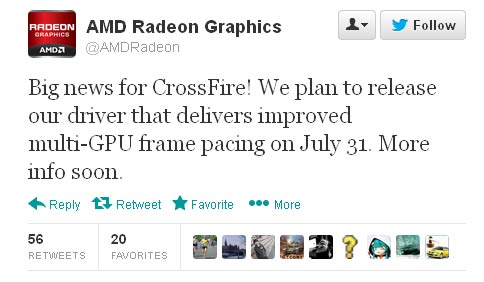AMD has tweeted advanced notice of its plans to release an updated driver to improve the performance of its Radeon graphics cards in CrossFireX configuration. The new driver, due on 31st July should it be on schedule, will implement “improved multi-GPU frame pacing” in the AMD Catalyst software, to eliminate such issues as micro-stutter.

Users running two AMD graphics cards (or a graphics card and an APU) have been suffering from some performance issues; the reported frame rates suggested smooth performance but users often experienced something else; stuttering. Apparently AMD CrossFireX solutions were rendering a large number of ‘runt’ frames which counted towards the reported frame rates but were never used to provide smooth gameplay action on screen.
CrossFireX should, in-theory, provide a significant boost to a user’s gaming frame rates. It is an attractive selling point for AMD’s APU’s, for example, when you can buy a relatively cheap graphics card and receive a big boost in 3D power. In our look at an AMD A10-5800K APU paired with a discrete Radeon HD 6670 we found that frame rate measurements could be up to 40 per cent better, like in Dirt Showdown, or practically non-existent, as in Batman: Arkham City. However even high end CrossFireX pairings suffered from micro-stuttering.
AMD promised a fix for these CrossFireX issues alongside the unveiling of the HD7990 earlier in the year. Nvidia had similar stuttering problems with its SLI configurations before its Kepler GPU introduction. “Frame pacing” is also the technique which Nvidia used to fix this issue.













